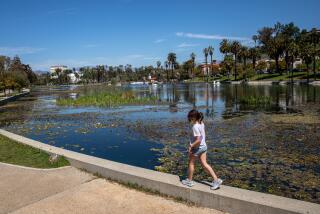Fines to Fund Environment Education : Sepulveda Basin: Van Nuys firm paid $165,000 for toxic discharges. Audubon Society plans to use its share to teach children about wildlife.
Pollution fines levied more than a year ago will fund an outdoor education program in the Sepulveda Basin Wildlife Area that will be offered to nearly 1,000 Los Angeles schoolchildren during the next year, the National Audubon Society has announced.
The pilot program will include classroom instruction and field trips to the 108-acre refuge near Burbank Boulevard and the San Diego Freeway that is a resting place for Canada geese and other migratory birds.
“Understanding the needs of animals and plants with whom they share the Sepulveda Basin can lead youngsters to a lifelong interest in caring for the world around them,” said Melanie Ingalls of Audubon’s education division.
The program will be the first use of money that Audubon obtained 17 months ago when a Van Nuys manufacturing firm was fined for illegal toxic discharges into city sewers. The Los Angeles city attorney’s office, which obtained $165,000 from ICI Americas Inc., gave $82,500 apiece to Audubon and the environmental group Heal the Bay in May, 1991.
Although long involved in planning how to use it, Audubon so far has had nothing to show for the money. And Bill Principe, a director of the group’s Los Angeles chapter, acknowledged a link between the timing of the announcement and the pending settlement of another pollution case that could support more environmental work in the basin.
That case involves two chemical spills from the Anheuser-Busch brewery in Van Nuys last January and February that polluted Haskell Creek, an intermittent stream that flows through the basin wildlife area. The case is scheduled for a hearing Monday before the Los Angeles office of the California Regional Water Quality Control Board.
Anheuser-Busch faces a maximum assessment of $124,000 for the spills involving 11,400 gallons of a caustic cleaning solution. Although they originally proposed a payment of $55,000, water board staff members now are seeking more from the giant brewer to help several environmental groups that are interested in the money. Audubon is expected to receive at least part of that money.
Along with outdoor education, the group is interested in restoring native vegetation along Haskell Creek “to build a living ecosystem,” Principe said. He said one reason for delays in using the $82,500 is that it isn’t enough to accomplish all of Audubon’s goals.
“We want to make sure we do it right, in a lasting way,” he said.
The pilot education program, which probably won’t start before spring, will cost about $25,000. Audubon officials said they hope they can expand it beyond an initial year.
The group will be working with the Topanga-Las Virgenes Resource Conservation District, which will train naturalists to lead school walks and help youngsters use binoculars and hand lenses to study the area.
“You’ve got a wonderful wildlife area right in the middle of the city, and we can talk a lot about . . . migratory birds, flood plain ecology and the general kind of habitat that’s here,” said Nancy Helsley, director of the resource conservation district.
The wildlife area, which features an 11-acre lake, is in the southeast corner of the 2,100-acre basin, which was once part of a huge desert grassland crossed by creeks and rivers.
The area lies under the Pacific Flyway, the major coastal route for birds migrating between Canada and Alaska and wintering grounds in Mexico and Central America.
More to Read
Sign up for Essential California
The most important California stories and recommendations in your inbox every morning.
You may occasionally receive promotional content from the Los Angeles Times.









